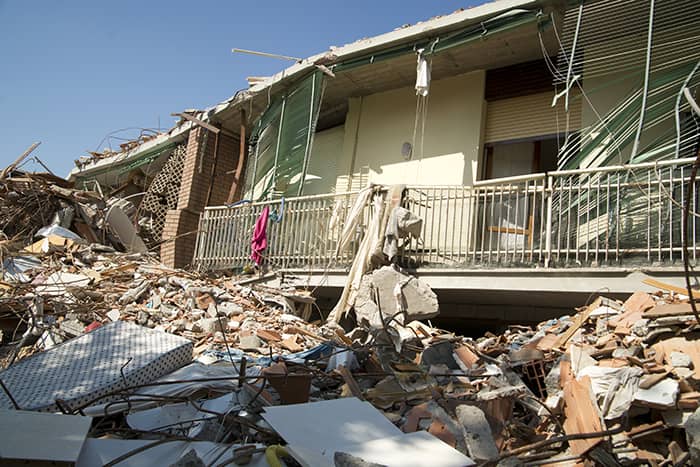10 Home Safety Tips to Keep Your Family Safe During an Earthquake

Having a safety plan when an earthquake or natural disaster unexpectedly acquires is important for the entire family. Being prepared will reduce the chances of being hurt by being out of harm’s way. There are 10 characteristics of an effective disaster recovery plan. It’s is important to teach young children to hide under a desk when the shaking starts.
According to California Earthquake Authority California has over 100 earthquakes each day. Even though these earthquakes are smaller quakes that most are not even felt scientists say that one day they can all happen at once and it will cause a mega-quake. On July 4th, 2020, Southern California was hit with a 6.4 and a 7.1 earthquake that lasted 12 seconds and was felt by over 20 million residents.
Check around your home for hazards, earthquake hazards include:
- Tall, heavy furniture such as bookcases, china cabinets, and modular wall units could topple over
- Water heaters could pull away from the wall and pipes causing them to rupture
- Appliances could move and rupture the gas and /or electrical lines
- Hanging plants in heavy pots could swing free from hooks
- Latches on kitchen cabinets and other cabinets will not hold the door open from shaking
- Breakables and /or heavy objects that are kept high on open shelves
- A masonry chimney could crumble and fall through an unsupported roof
- Flammable liquids, painting, or cleaning products are safer in the garage or an outside shed.
To get more information on earthquake safety hazards, check out the FEMA 528 form located here.
Fire Safety Tips
When a home catches on fire, families have as little as one to two minutes to escape from the time a smoke alarm sounds.
- Install smoke alarms inside bedrooms, outside sleeping areas, and on every level of your home
- Test alarms each month. Change batteries as needed.
- Discuss a fire escape plan with family members at least 2X per year.
- When a fire occurs, GET OUT, STAY OUT and CALL FOR HELP. Never go back inside to get anyone or anything.
And when newer homes catch on fire, they burn faster and also produce toxic gas from the materials used to build, so it especially important to have a home escape plan.
10 Home Safety Tips for When an Earthquake Hits
- Draw a map with all the members of your household. Marking down two exits from each room plus a pathway to the outside from each exit.
- Practice fire drills twice a year and conduct one a night, and one during the day with everyone in your home. Practice using different scenarios and ways out.
- Educate children on fire safety and teach children how to escape on their own in case you are unable to help them.
- Make sure all windows and doors that lead to outside open easily. All family members understand and practice how to operate and open locked windows or doors in order to escape.
- Assign one designated person to help a family member with mobile disabilities such as infants, older adults, and /or people with mobile disabilities. Make sure to assign someone to assist them during a fire drill to be prepared in the event of an emergency. Assign a backup in case that person is absent.
- When you see smoke, do not open doors. Also, when you touch the door and it is hot, do not open the door.
- Practice crawling low. In the event of a fire, smoke and poisonous air hurt more people than the actual flames. Stay low to the ground and crawl below the smoke.
- Designate the meeting place outside of the home, stay outside and stay close together to best help first responders.
- When CO2 detector sounds, leave the home immediately and call 911, the CDC warns.
- Keep low to avoid fumes.
Prepare for Mudslides
Mudslides and landslides can occur at any given location and especially when your home is on a hill. Side of a mountain, or along a canyon wall, or other types of a slope, the potential for a mudslide to occur exists. The most common causes of mudslides are flash floods or earthquakes. There is no way to predict when one will happen.
Stay Focused
Pay attention to the landscape near or on your property, especially during heavy rainstorms or flash floods. Also, look for natural areas where a great deal of runoff occurs, be sure to keep an eye out for smaller mudslides because it is an indication a larger one can happen there in the future. Keep your eyes out on the places where more runoff stream converges, because this too can lead to mudslides. A sign to also look out for is when trees start to tilt or look as if they’re starting to tip over. When land under your property is shifting it can also lead to cracks in your concrete driveway and sidewalks.
Landscaping
Landscaping by planting trees can be a way to stabilize a hillside. Though it takes years for a tree to develop an adequate root structure and all of your efforts will be wiped out by a flash flood. So consider your options before the investment.
Vehicle Maintenance
Vehicle Maintenance when there is a catastrophic event and you must evacuate your home. So be sure to do regular checkups on your car vehicle maintenance tasks and tune-ups. Also, consider purchasing a four-wheel-drive vehicle because it will help you get out when roads are washed out by a mudslide.
Electrical Issues
Electricity will also be knocked out for several days and store shelves will b be wiped clean, so stock up with non-perishable foods (as mentioned before) and have plenty of purified water along with other necessities.